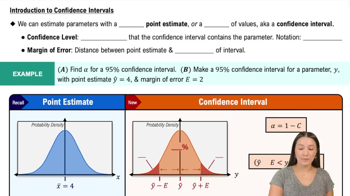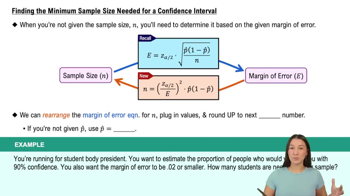Here are the essential concepts you must grasp in order to answer the question correctly.
Sample Size Calculation
Sample size calculation is a statistical method used to determine the number of observations or replicates needed in a study to achieve a desired level of precision. It involves considering factors such as the population standard deviation, the desired confidence level, and the margin of error. In this case, we need to calculate how many airline pilots' IQs should be sampled to ensure that our estimate is accurate within two points of the true mean.
Recommended video:
Sampling Distribution of Sample Proportion
Confidence Level
The confidence level represents the degree of certainty that the population parameter lies within a specified range of the sample estimate. A 99% confidence level indicates that if we were to take many samples, approximately 99% of the calculated confidence intervals would contain the true population mean. This high level of confidence requires a larger sample size to ensure that the estimate is reliable.
Recommended video:
Introduction to Confidence Intervals
Margin of Error
The margin of error is the range within which the true population parameter is expected to fall, given a certain level of confidence. In this scenario, a margin of error of two IQ points means that we want our sample mean to be within two points of the actual mean IQ of airline pilots. This concept is crucial for determining how precise our estimate needs to be and directly influences the required sample size.
Recommended video:
Finding the Minimum Sample Size Needed for a Confidence Interval






